SWL Series Worm Gear Screw Jack for Jump Form Construction Lifting
Worm gear screw jack is through the worm gear drive screw to complete the lifting, lowering, promoting, and other functions, widely used in machinery, metallurgy, construction, water conservancy, the chemical industry, and other industries, with structural tight paint, small volume, easy installation, good reliability, high stability, long service life, and other advantages. THE worm gear screw jack can be directly driven by a motor or other power, or it can be manually driven. It has different structure types and assembly types, and the lifting height can be customized according to user requirements.
SWL Series Worm Gear Screw Jack for Jump Form Construction Lifting
The SWL series worm gear screw jack is through the worm gear drive screw to complete the lifting, lowering, promoting, and other functions, widely used in machinery, metallurgy, construction, water conservancy, the chemical industry, and other industries, with structural tight paint, small volume, easy installation, good reliability, high stability, long service life, and other advantages. This series of worm gear screw jacks can be self-locking, carrying a capacity between 2.5t-150t and a maximum input speed of 1500r/min. The operating temperature is between -20℃ and 100℃. The worm gear screw jack can be directly driven by a motor or other power, or it can be manually driven. It has different structure types and assembly types, and the lifting height can be customized according to user requirements.
SWL Series Worm Gear Screw Jack Design
Specification:
| Structural form | Type Ⅰ: axial movement of the screw rod | Type Ⅱ: the screw rod rotates, and the nut moves axially |
| Assembly type | Type A – a rod (or nut) moves upward | Type B — screw rod (or nut) moves downward |
| Screw head type | The screw head of Type 1 structure type includes Type I (cylindrical type), Type II (flange type), Type III (threaded type), and Type IV (flat head type); | The screw head part of the type 2 structure is of type I (cylindrical type) and type III (threaded type) |
| Transmission ratio | Normal speed ratio (P), slow speed ratio (M) | |
| Lifting the bearing capacity | 2.5,5,10,15,20,25,35( × 10kN) seven kinds | |
| Protection of screw rod | Type 1 structure includes basic type, anti-rotation type (F), and types with a protective cover (z); | Type 2 structure includes the basic type and type with a protective cover (Z) |
Type Ⅰ Worm Gear Screw Jack Structural Style
Type Ⅱ Worm Gear Screw Jack Structural Style
SWL Series Worm Gear Screw Jack Parameter:
| Type | Structural Style | Model | Output Torque | Screw Diameter | Max. Power | Net Weight (without screw stroke) |
| (KN) | (mm) | (KW) | (KG) | |||
| SWL Screw Jack | I Type | SWL2.5 | 25 | Tr30X6 | 0.55 | 7.3 |
| SWL5 | 50 | Tr40X7 | 1.1 | 16.2 | ||
| SWL10 | 100 | T58X12 | 2.6 | 25 | ||
| SWL15 | 150 | T58X12 | 2.6 | 25 | ||
| SWL20 | 200 | Tr65X12 | 3.7 | 36 | ||
| II Type | SWL | 250 | Tr90X16 | 4.8 | 70.5 | |
| SWL35 | 350 | Tr100X18 | 6 | 87 | ||
| SWL50 | 500 | Tr120X20 | 7.5 | 420 | ||
| SWL100 | 1000 | Tr160X23 | 15 | 1010 | ||
| SWL120 | 1200 | Tr180X25 | 17.5 | 1350 |
Performance Parameters of the Worm Gear Screw Jack:
|
MODEL
|
SWL2.5
|
SWL5
|
SWL10
|
SWL15
|
SWL20
|
SWL25
|
SWL35
|
|
|
Maximum lifting force (kN)
|
25
|
50
|
100
|
150
|
200
|
250
|
350
|
|
|
Screw thread size
|
Tr30*6
|
Tr40*7
|
Tr58*12
|
Tr58*12
|
Tr65*12
|
Tr90*16
|
Tr100*20
|
|
|
Maximum tension (kN)
|
25
|
50
|
99
|
166
|
250
|
350
|
||
|
Worm gear ratio (mm)
|
P
|
1/6
|
1/8
|
3/23
|
1/8
|
3/32
|
3/32
|
|
|
M
|
1/24
|
1/24
|
1/24
|
1/24
|
1/32
|
1/32
|
||
|
Worm non-rotating stroke (mm)
|
P
|
1.0
|
0.875
|
1.565
|
1.56
|
1.5
|
1.875
|
|
|
M
|
0.250
|
0.292
|
0.5
|
0.5
|
0.5
|
0.625
|
||
|
Maximum elongation of screw rod under tensile load (mm)
|
1500
|
2000
|
2500
|
3000
|
3500
|
4000
|
||
|
Maximum lifting height at maximum pressure load (mm)
|
The head of the screw rod is not guided
|
250
|
385
|
500
|
400
|
490
|
850
|
820
|
|
Lead screw head guide
|
400
|
770
|
1000
|
800
|
980
|
1700
|
1640
|
|
|
Worm torque at full load(N.m)
|
P
|
18
|
39.5
|
119
|
179
|
240
|
366
|
464
|
|
M
|
8.86
|
19.8
|
60
|
90
|
122
|
217
|
253
|
|
|
efficiency(%)
|
P
|
22
|
23
|
20.5
|
19.5
|
16
|
18
|
|
|
M
|
11
|
11.5
|
13
|
12.8
|
9
|
11
|
||
|
Weight without stroke(kg)
|
7.3
|
16.2
|
25
|
36
|
7.05
|
87
|
||
|
Weight of screw rod per 100mm(kg)
|
0.45
|
0.82
|
1.67
|
2.15
|
4.15
|
5.20
|
||
SWL Series Worm Gear Screw Jack Features:
Here are some of the key features of the worm gear screw jack:
1. Compact structure and small size: The screw jack has a compact structure and small size, which makes it easy to transport and store.
2. Lightweight: The worm gear screw jack is lightweight, which makes it easy to operate and maneuver.
3. Low noise: The screw jack operates with low noise, which makes it ideal for use in noise-sensitive environments.
4. Safe and convenient installation: The worm gear screw jack is safe and easy to install.
5. Flexible use:SWL series worm gear screw jack can be used individually or in combination, which makes it versatile and adaptable to a variety of applications.
6. High reliability: The screw jack is highly reliable and durable, which ensures long-lasting performance.
7. Long service life: The SWL series worm gear screw jack has a long service life, which reduces the need for frequent replacement and maintenance.
8. Can be used individually or in combination: The worm gear screw jack can be used individually or in combination, which allows for greater lifting capacity and flexibility.
9. Can control and adjust the height of the promotion accurately: The SWL series worm gear screw jack can control and adjust the height of the promotion accurately, which ensures precise positioning and movement.
10. Suitable for low speed, low-frequency operations: The SWL series worm gear screw jack is suitable for low-speed, low-frequency operations, which makes it ideal for a variety of applications.
11. Widely used in machinery, metallurgy, water conservancy, chemical industry, medical treatment, culture, health and other industries: The SWL series worm gear screw jack is widely used in a variety of industries, which makes it a versatile and adaptable lifting device.
If you are looking for a basic lifting device that is compact, lightweight, low noise, safe, reliable, and long-lasting, the SWL series worm gear screw jack is a great option. It is suitable for a wide range of applications and is sure to meet your needs.
Other Different Types of Worm Gear Screw Jacks
| Screw Movement Type of Screw Jack | Nut Movement Type of Screw Jack |
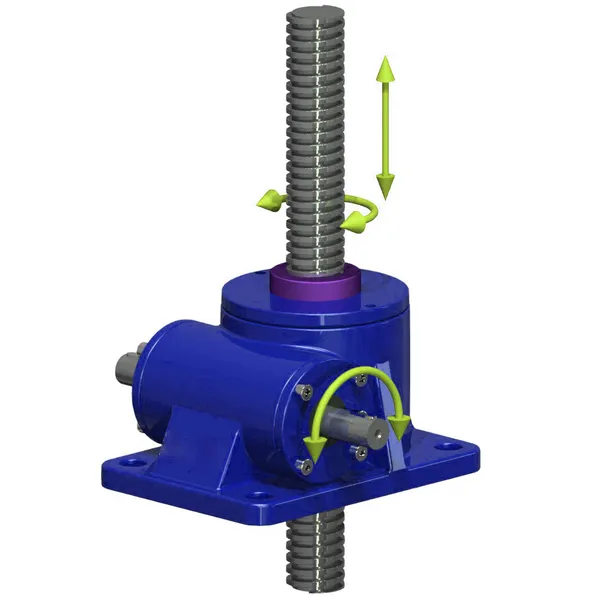 |
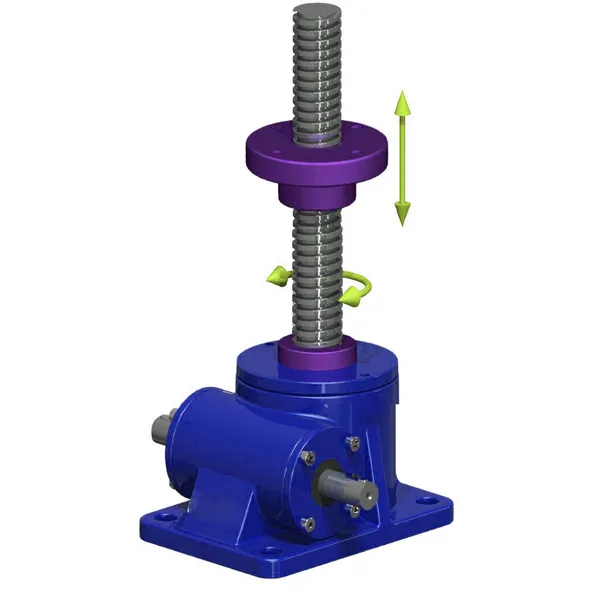 |
| Hand Wheel Worm Gear Screw Jack | Motorized Worm Gear Screw Jack |
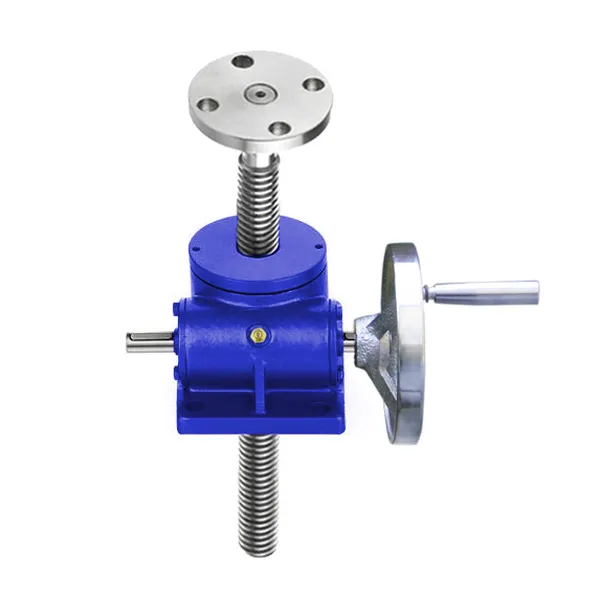 |
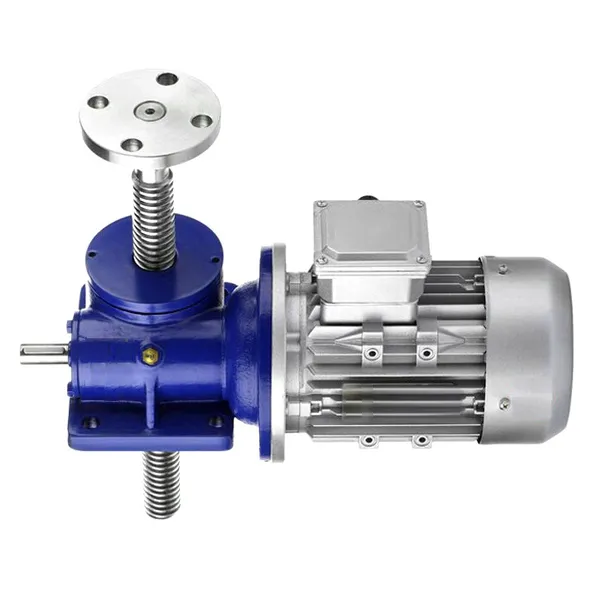 |
The Difference Between Screw Jacks and Hydraulic Jacks
Screw jacks and hydraulic jacks are both mechanical devices used for lifting heavy loads. However, they operate on different principles and have different advantages and disadvantages.
Screw jacks, such as the SWL series worm gear screw jack, use a worm gear and screw mechanism to lift loads. They are typically powered by a motor or hand crank and are self-locking, which means they will hold the load in place once they are stopped. Screw jacks are precise and can be used for fine positioning of loads. They are also low maintenance and have a long service life. However, they have a slower lifting speed and a lower load capacity compared to hydraulic jacks.
Hydraulic jacks, on the other hand, use pressurized hydraulic fluid to lift loads. They are typically powered by a pump and can lift heavy loads quickly and efficiently. Hydraulic jacks also have a higher load capacity than screw jacks. However, they require more maintenance than screw jacks and can be more expensive to operate.
The choice between screw jacks and hydraulic jacks depends on the specific application and requirements. Screw jacks are often used for precise positioning of loads and in applications where low maintenance is important, while hydraulic jacks are used for lifting heavier loads quickly and efficiently.
SWL Series Worm Gear Screw Jack Applications
The SWL series worm gear screw jack is a versatile lifting device that can be used in a wide variety of applications. It is commonly used in the following industries:
(1) Machinery: The SWL series worm gear screw jack is used in a variety of machinery applications, such as lifting and positioning heavy objects, loading and unloading vehicles, and moving objects around a work area.
(2) Metallurgy: The SWL series worm gear screw jack is used in metallurgy applications, such as lifting and positioning steel beams, loading and unloading molten metal, and moving objects around a manufacturing plant.
(3) Water conservancy: The SWL series worm gear screw jack is used in water conservancy applications, such as lifting and positioning heavy objects, loading and unloading water pipes, and moving objects around a construction site.
(4) Chemical industry: The worm gear screw jack is used in chemical industry applications, such as lifting and positioning hazardous materials, loading and unloading chemicals, and moving objects around a laboratory.
(5) Medical treatment: The worm gear screw jack is used in medical treatment applications, such as lifting and positioning patients, loading and unloading medical equipment, and moving objects around a hospital.
(6) Culture and health: The worm gear screw jack is used in culture and health applications, such as lifting and positioning exhibits, loading and unloading supplies, and moving objects around a museum or library.
The worm gear screw jack is a reliable and durable lifting device that can be used in a wide variety of applications. It is a safe and efficient way to lift, move, and position heavy objects.
China Worm Gear Screw Jack Manufacturers
We are the factory with the ability to customize the worm gear screw jacks to your specific requirements for your application. Please share detailed information, including your use scenario, required loading capacity, reduction ratio, power source, stroke length, and other requests. Our sales and technical team will provide solutions and drawings for your confirmation.
Worm Gear Screw Jacks Model Selection Guide:
Step 1: Select the corresponding model according to your load capacity requirements,
Step 2: Confirm the reduction ratio: 1/6, 1/12,1/24. If you need a special speed ratio, please contact our sales team.
Step 3: Determine the head form of the screw; there are cylinder type, nut type, flange type, thread type, and flat head type for your option.
Step 4: Confirm the screw length or stroke you need. The default stroke is 500mm, and the screw length can be customized according to different needs.
Step 5: Confirm the accessories you need, such as matching motors, hand wheels, protection tube for screws, dust cover, anti-rotation functions, nuts, etc.
Contact us now to get your customized worm gear screw jack.
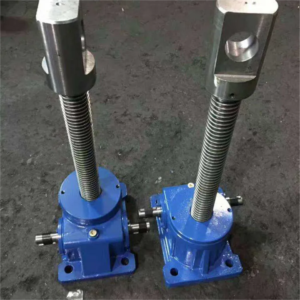 |
 |
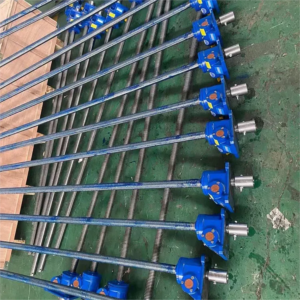 |
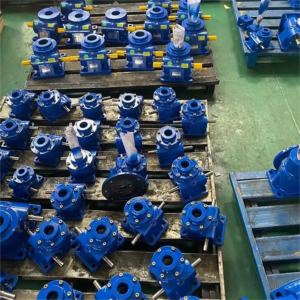 |
FAQ
Q1: What is a worm gear screw jack?
A: A worm gear screw jack is a mechanical device that converts rotary motion into linear motion. It consists of a worm gear (a helical gear) and a screw (a threaded rod) that engage with each other to move a load in a vertical or horizontal direction.
Q2: What are the components of a worm gear screw jack?
A: The main components of a worm gear screw jack include the housing, the worm gear, the screw, the bearing, the lubrication system, and the motor (if it is motorized).
Q3: What are the advantages of using a worm gear screw jack?
A: Some advantages of using a worm gear screw jack include high load capacity, high efficiency, self-locking ability, and the ability to hold a load in position without the need for external brakes or locking mechanisms.
Q4: What is the load capacity of a worm gear screw jack?
A: The load capacity of a worm gear screw jack depends on various factors, such as the diameter of the screw, the pitch of the screw, the number of threads on the screw, the lead angle of the worm gear, and the material and quality of the components used. The load capacity can range from a few hundred pounds to several hundred tons.
Q5: What is the efficiency of a worm gear screw jack?
A: The efficiency of a worm gear screw jack is typically around 30-40%. This means that only 30-40% of the input power is converted to useful output power, while the rest is lost as heat and friction.
Q6: How do I select the right worm gear screw jack for my application?
A: To select the right worm gear screw jack for your application, you need to consider various factors such as the load capacity, the required speed and travel distance, the duty cycle, the environmental conditions, and the mounting options. You can consult with a supplier or manufacturer to help you choose the right product for your specific needs.
Q7: How do I maintain a worm gear screw jack?
A: To maintain a worm gear screw jack, you need to follow the manufacturer’s recommendations for lubrication and inspection. You should regularly check the lubrication system and replace the lubricant if necessary. You should also check the components for wear and damage and replace them if needed.

Packing Shipping Delivery
  |
 |
|
 |
 |
|
How to choose power transmissions parts and industrial products which meet our requirement
| Chains | Sprockets | Pulleys | Timing belt Pulley | V-belt Pulley |
| Sheaves | Coupings | Bush &Hub | Gear& Rack | V-Belt |
| Locking Assembly | Pulley | Gearbox | Reducer | Shaft Collar |
| Rod End Bearing | Clevis | PTO | Chain Guide | Belt Guide |
| Rubber Buffer | Chain Tensioner | PTO Drive Shafts | Universal Joints | Roller Chains |
| Conveyor Chains | V-Belts | Worm Gearbox | Helical Gear | Worm |
| Agricultural Chain | CNC Proces Parts | Casting | Stamping | |
| Powder Metallurgy | CNC Proces Parts | Casting | Stamping |
What Products Do you sell ?
We are a group of factories, give customer one stop solution of power transmission and industrial products. We are in the position to supply wide range of products, including chains, sprockets, v-belt and v-belt pulleys, timing belt and timing belt pulleys, gears, speed reducers, motors, racks, couplings, and many other parts, like locking assembly, taper bushing, Chain guide, shaft collar, torque limiter, cam clutch, universal joint, motor base and motor slide, rod end, clevis, rubber mount, etc. We make special parts according to drawings and/or samples.
How to choose a gearbox which meets our requirement?
You can refer to our catalogue to choose the gearbox or we can help to choose when you provide
the technical information of required output torque, output speed and motor parameter etc.
What information shall we give before placing a purchase order?
a) Type of the gearbox, ratio, input and output type, input flange, mounting position, and motor informationetc.
b) Housing color.
c) Purchase quantity.
d) Other special requirements.
What industries are your gearboxes being used?
Our gearboxes are widely used in the areas of textile, food processing, beverage, chemical industry,
escalator,automatic storage equipment, metallurgy, tabacco, environmental protection, logistics and etc.
What is the producing process?
Production process including raw material cutting, machine processing, grinding, accessories cleaning, assemble, cleaning, stoving, oil coating, cover pressing, testing, package.
How to control the products quality?
Combining advanced equipment and strict management, we provide high standard and quality bearings for our customers all over the world.
What is the transportation?
-If small quantity , we Suggest to send by express, such as DHL,UPS, TNT FEDEX. If large amount, by air or sea shipping.
Can we design packaging?
-Yes. Default is regular packing, and we can make customer's own packing.
Can you provide OEM service?
-Yes, we work on OEM orders. Which means size, quantity, design, packing solution, etc will depend on your requests; and your logo will be customized on our products.
Can you give me discount on Power Transmissions Parts and Industrial parts?
-Yes, of course. Pls. send me your Email, you'll get more
Q: Are You a trading company or a manufacturer?
A: We Are the factory and have our Own trading company
Q: How Can I get an offer?
A: please send US quotation information: drawings, materials, weight, quantity and requirements, we can accept PDF, ISGS, DWG, STEP file format. If you don't have the drawings, please send us the samples, we can also quote you according to your samples.
Q: What is your minimum order size?
A: it is usually 100 pieces, but a low quantity is acceptable under some special circumstances.
Q: Do you provide samples? Is it free or extra?
A: Yes, we can provide samples free of charge, but we don't pay the freight.
Q: What is the lead time for mass production?
A: honestly, it depends on the number of orders. Normally, if you don't need the tools, deposit them after 30 days or so.
Q: What if the parts don't Work?
A: we can guarantee the quality, but if it happens, please contact us immediately, take some photos, we will check the problem and solve it as soon as possible.
Q: What are your terms of payment?
A: payment is less than US $1000,100% in advance. Payment: $1000,50% wire transfer in advance, balance before shipment,Other Terms of payment are negotiable

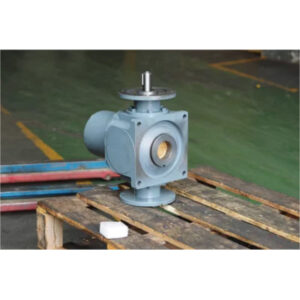
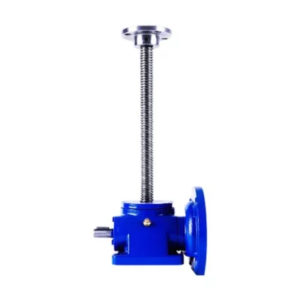
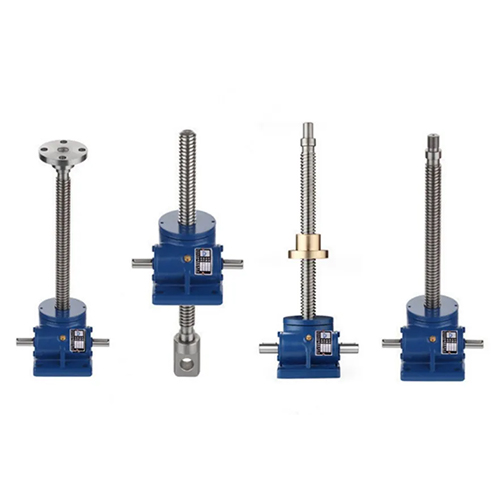
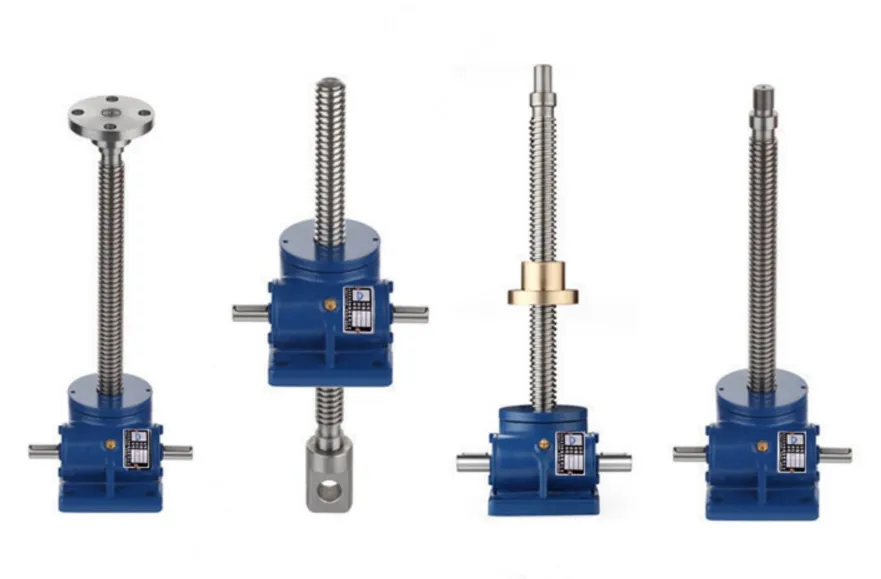
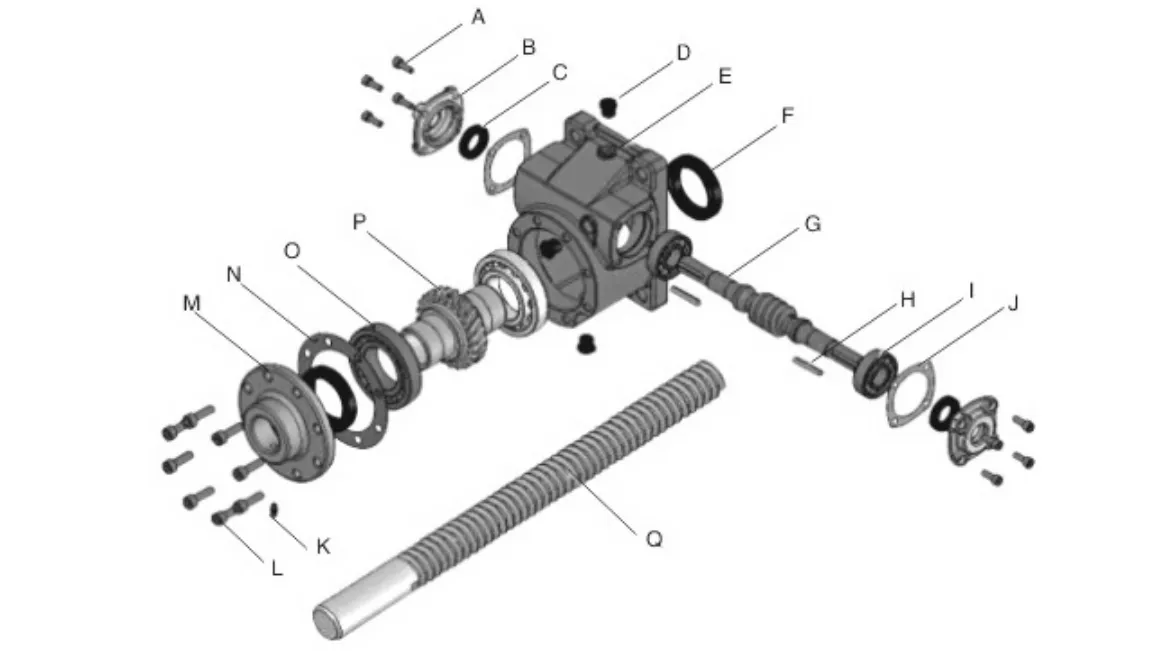

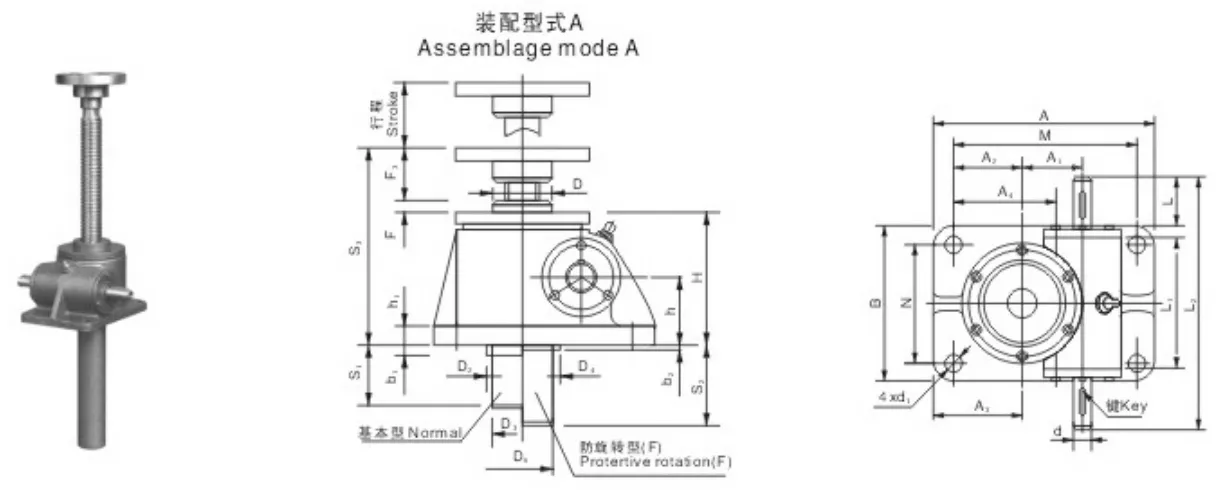
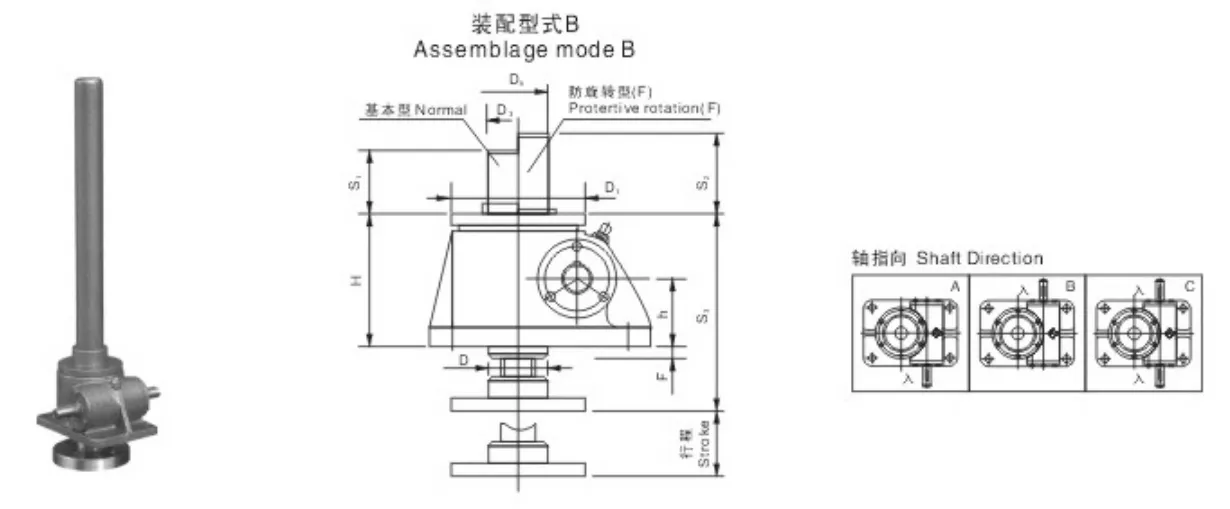

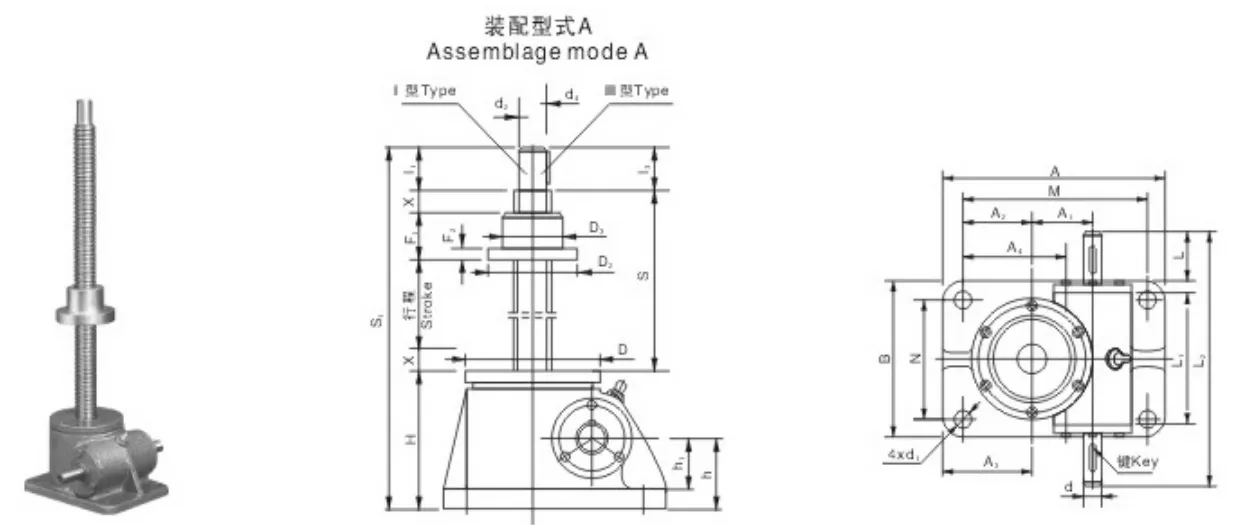

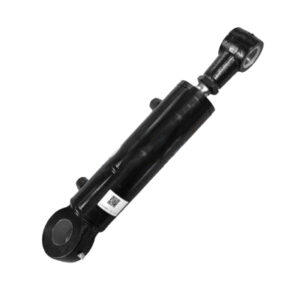


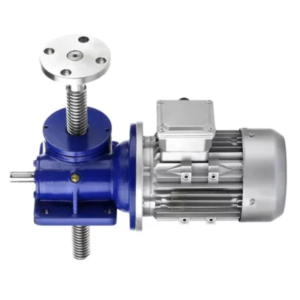

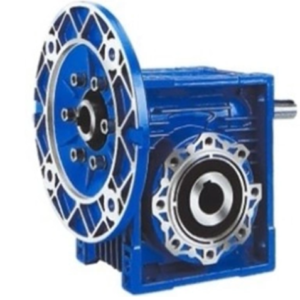
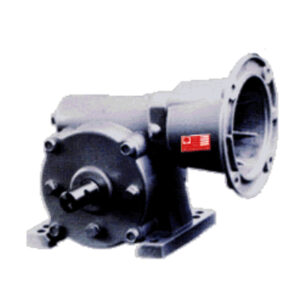
Reviews
There are no reviews yet.